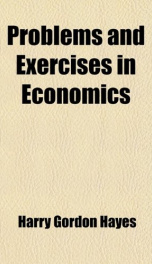problems and exercises in economics

Purchase of this book includes free trial access to www.million-books.com where you can read more than a million books for free. This is an OCR edition with typos. Excerpt from book: III. THE INDUSTRIAL EXPANSION OF THE UNITED STATES. 1. " The industrial opportunities that prevailed in the United States during the last two centuries made the laissez-faire principle inevitable." Give supporting argument. 2. " Very early the North and South began to quarrel about protection to manufacturing industries." a. State explicitly just why there was a conflict of interest in regard to protection. b. Does this conflict of interest still exist? If so, has it at all abated? Cite evidence in support of your answers. / a 3- State the chief economic advantage that has resulted from the development of our railroads; the political advantage; the general social advantage. 4. Account for the fact that in Iowa alone there was not an increase in population during the decade ending 1910. 5. What are the economic forces back of the relalively large increase of urban population as compared with rural population? 6. Cite evidence to support " the growing conviction that in protecting liberty and property the government of the United States has neglected the interests of equality." 7. "From 1899 to 1909 the number of wage- earners in manufacturing establishments increased 40 per cent and the value of the products increased 81 per cent." What is the significance of this statement? Would the increase in the volume of manufactured goods as compared with the increase in the number of laborers in manufacturing establishments be more vital than this comparison? Explain. 8. " In 1850 we produced 1 ton of cereals per person. In 1900, with a smaller proportion of our population engaged in agriculture, we produced 1 tons of cereals per person."Smith, Industrial and Commercial Geography, p. 556. How do you account for this increase in product per person? Q. " ...
Info about the book
Author:
Series:
Unknown
ISBN:
0749462299
Rating:
3.5/5 (5)Your rating:
0/5
Languge:
English
Users who have this book
Users who want this book
What readers are saying
What do you think? Write your own comment on this book!
write a commentif you like problems and exercises in economics try:
Other books by this author
Do you want to read a book that interests you? It’s EASY!
Create an account and send a request for reading to other users on the Webpage of the book!

